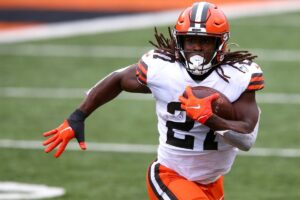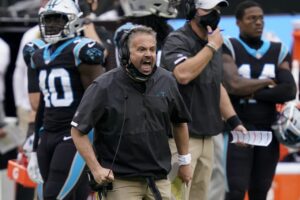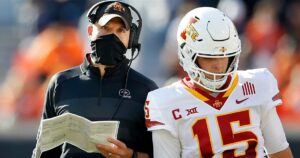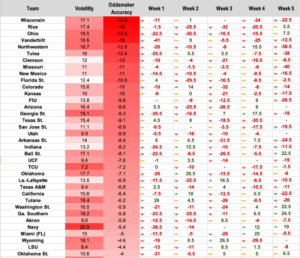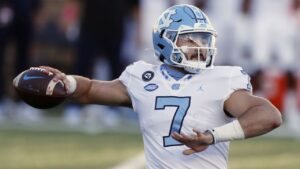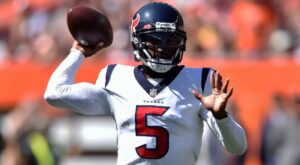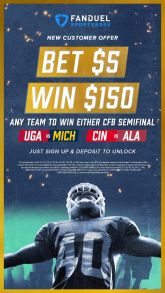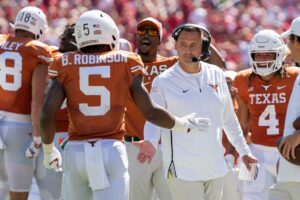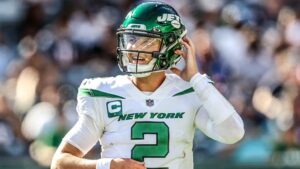Written by Andrew Borland of SportSource Analytics
If you listen to bettors with an edge, you’ll hear a lot of talk about “Efficiency” or “Success Rate.” These words flow seamlessly throughout the BetTheBoard Podcast with regularity (usually by Payne). Writing provided the perfect vehicle to do a deep dive into the background of this statistic and explain exactly what it means and how it’s derived.
Below, we’ll cover how these metrics are calculated in the analytics world and how a bettor can understand, rationalize, and assess value from these metrics when when you hear how sharper bettors use them to evaluate teams.
Place Your Bets All Fall at Fanduel.com/BetTheBoard and start with a RISK FREE $1,000
What’s In a Name
First, let’s start with the aliases. “Success Rate”, “Success”, “Play Efficiency”, “Efficiency Rate;” they are all the same thing. In the most general description they’re all about a team’s ability to stay ahead of the sticks (or “on schedule”). However what does that mean quantitatively? There are a few variants of the calculation in the football analytics community. At SportSource, our generally accepted standard (by our 60+ FBS coaching staff clients) is pretty straightforward.
A play is “Efficient” or “Successful” if:
- On First Down…
- A play gains 40% of the required yards. For 1st and 10 (most common) a play must gain 4 or more yards to be considered efficient/successful.
- On Second Down…
- A play gains 50% of the required yards. For 2nd and 10, the play must get 5 or more yards, a 2nd and 7 needs 4 or more yards, etc.
- On Third Down or Fourth Down…
- A play converts the first down or scores a touchdown.
Follow Bet The Board on Twitter ?
@BetTheBoardPod – twitter.com/BetTheBoardPod
Follow the Hosts ?
@ToddFuhrman – twitter.com/ToddFuhrman
@Payneinsider – twitter.com/PayneInsider
Providing Perspective
Now for a little more context. In 2021, college football teams are averaging a 48.3% overall success rate. Ironically it is also exactly 48.3% in the NFL so far in 2021. Elite teams are generally over 53%+ while inefficient teams are less than 47%.
Nuanced Numbers
Standard box scores provide very little insight on efficiency except for 3rd and 4th downs. These are obviously extremely critical because they ultimately determine what keeps a team’s offense on or off the field during a drive. We often see the graphic in every game we watch; showing that a team is “struggling on 3rd Down” and that’s directly correlated to why they may be losing a game. That graphic is generally misleading and a symptom rather than the heart of the problem. In 2021, 44.9% of college football plays are first down plays (44.7% in the NFL). Inefficient First Downs are the root cause of subsequent issues on second and third Down.
Conceptually, this is all fine and good but how does this contribute to meaningful betting information?
Parsing the Data
Let’s take a look at valuable pieces of data from 2021 FBS College Football Games.
- The team more efficient on First Down is 324-227-6 ATS (59%)
- Underdogs – 91-47-1 (66%)
- Favorites – 231-180-5 (56%)
- The team more efficient on Third Down is 340-193-6 ATS (64%)
- Underdogs – 113-48-0 (70%)
- Favorites – 226-144-6 (61%)
- A team more efficient on BOTH First and Third Down in a game is 234-103-5 ATS (69%)
- Underdogs – 47-8-0 (85%)
- Favorites – 186-95-5 (66%)
Teams winning the efficiency battle control the game and cover spreads. Just as importantly they set up drives to consistently score points. When we work with our coaching staffs, we often contrast just how critical first down efficiency is to scoring points. We talk about “P and 10”, which is a special first down. It is the first First Down of the Possession (or Drive), hence the “P”. How important is it to be efficient on this down? Let’s look at 20,000+ drives at both the FBS and FCS level this college football season.

When teams are efficient on “P Down” the chance of scoring on that drive is 45.3%. If that first play is inefficient, the chance of scoring on that possession drops to 26.9%. Quite a dip. First Down is really a “money down.” More importantly the first First Down of a drive is the “money” down.
When evaluating a team and looking for value, a great place to look is offensive efficiency. Points and yards can get really noisy with garbage time and non-competitive situations. Finding teams (especially underdogs) that have highly efficient offenses should definitely jump off your bet sheet most weeks.
So when you start digging for teams with favorable matchups, find the efficiency numbers (for offense AND defense). Most importantly, find the first down efficiency numbers because they may be much more telling than what a team accomplishes on third down.
Subscribe to Bet The Board Podcast ?
Apple Podcasts: apple.co/3mdGgbz
SoundCloud: bit.ly/3bR66gK
Google Podcasts: bit.ly/2RgfdxR
Spotify: spoti.fi/3jjDJwL
Source: https://www.bettheboardpodcast.com/2021/11/15/college-football-efficiency-101/
- 7
- All
- analytics
- Apple
- ATS
- Battle
- bet
- Betting
- board
- Box
- Cause
- clients
- College
- college football
- Common
- community
- data
- Defense
- Edge
- efficiency
- efficient
- Evaluate
- fine
- First
- flow
- Football
- Free
- game
- Games
- General
- good
- great
- How
- HTTPS
- image
- important
- importantly
- information
- issues
- IT
- jump
- Level
- May
- Metrics
- NFL
- numbers
- play
- podcast
- Podcasts
- possession
- Risk
- seamlessly
- set
- So
- start
- stay
- straightforward
- subsequent
- success
- The
- time
- value
- vehicle
- Watch
- What
- winning
- words
- Work
- world
- writing

